 Facebook
Facebook
 X
X
 Instagram
Instagram
 TikTok
TikTok
 Youtube
Youtube
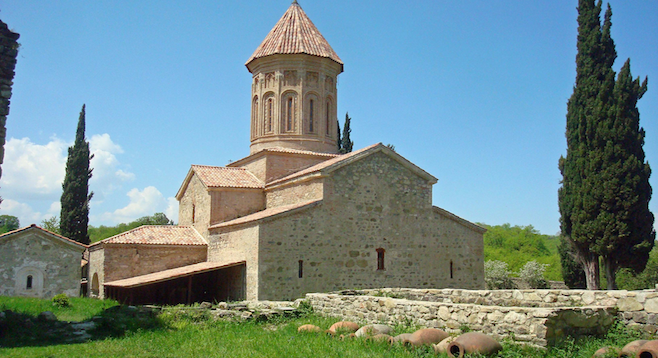
Google “Georgia,” and you are much more likely to get recipes for peach pie than to learn about the unique ex-Soviet republic where wine was invented and a special language and culture survived a thousand years of foreign occupation. Today, it celebrates its links with Europe and America more than its association with the Orient.
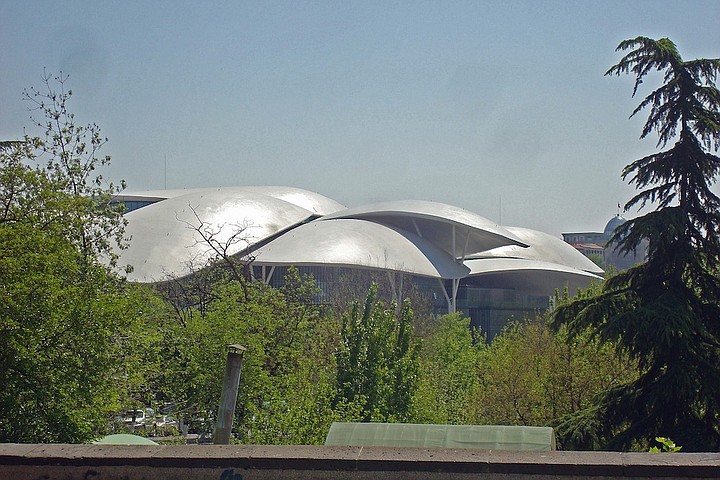
In its capital city, Tbilisi, we saw something truly unique in the world: a major avenue named after George W. Bush!
This country of Georgia is a small swatch of land about the size of West Virginia (but with higher mountains!) at the far eastern end of the Black Sea, the bottom of Russia and the top of Iran. Other neighbors include Turkey, Armenia, Azerbaijan and Chechnya. All in all, a dicey neighborhood (which is why they cozied up to George W.)!
So, why go to Georgia? The country is definitely under-touristed. In our two weeks there, we were never even able to locate a map of Tbilisi. But just because the rest of the world hasn’t found it, doesn’t mean that there aren’t some very good reasons to visit.
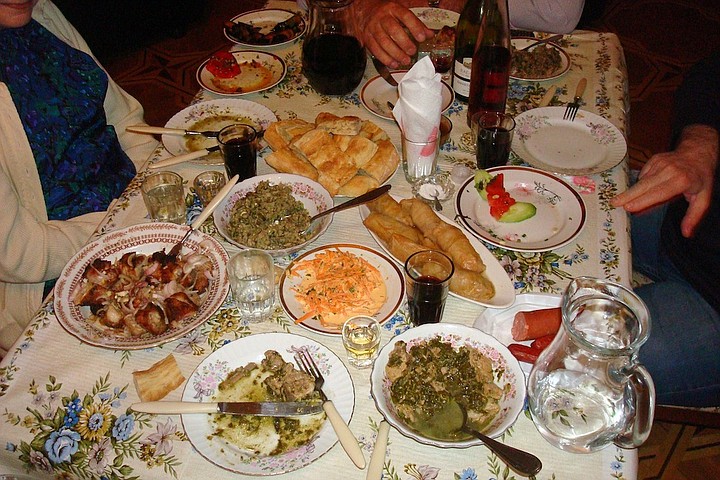
Foremost on our list was the fabulous cuisine. Tasty, rich and piquant, Georgian cuisine is the natural result of a fertile, mineral-rich landscape and a parade of interloping cultures trading or invading between the East and the West. Staunchly proud of their culture, the Georgians have developed unique foods that are simply not available elsewhere. Think khachapuri, with oozy cheese enveloped in a yeast bread, fourteen varieties to choose from, and each fifty cents or less (things were generally very cheap). Or yummy eggplant with walnut sauce. Or bean stew with a delicious corn muffin sitting on top. Instead of teaspoons of spices, Georgians are apt to add a fistful of coriander or basil, and often use a blend of spices called khmeli suneli that is a complex, fragrant mixture of sour, grassy and nutty flavors.
And the best place to sample the agricultural products is at their source. To do so, we traveled to the wine country of Kakheti in a most spiffy twenty-year-old Mercedes, powered by clean and economical compressed natural gas, which seems to be the fuel of choice here.
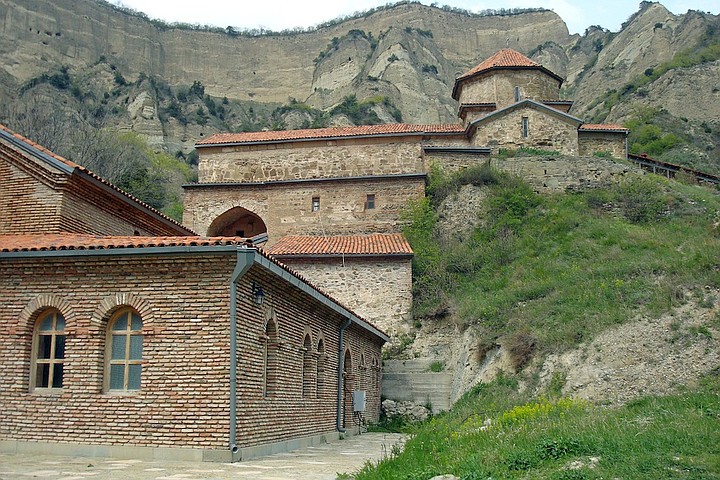
Under the gaze of the snowcapped Caucasus Mountains, we stopped at a number of monasteries, a second reason to visit Georgia. One was Ikalto (top), established by Syrian missionaries in the 500’s A.D., and the site for the next 1,000 years of the only real higher learning academy in the region. It was burned by Persians in 1616, but still contains the remains of three churches. But even more prominent than the churches are the brothers' wine vaults, which provided the perfect venue to learn how the Georgians produce this nectar. Many archaeologists believe Georgia to be the first to cultivate grapevines over 8,000 years ago, and it is still a major source of domestic and export revenue.
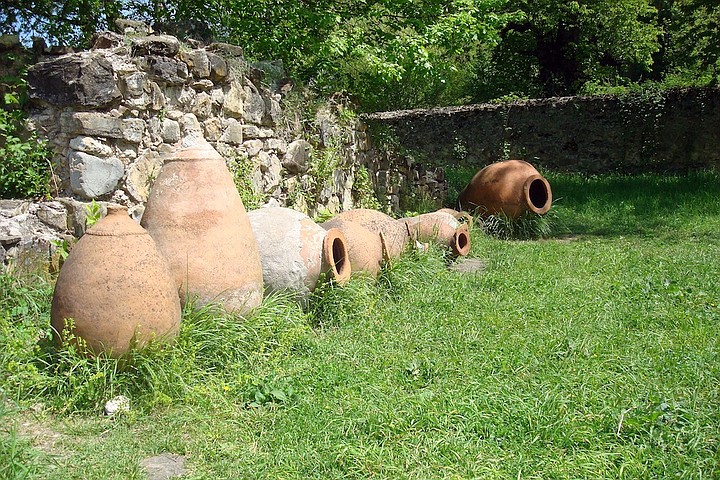
Grapes are grown on every square inch of soil, and, it seemed, in the yard of every home – city and countryside alike. The traditional oenological method: once the grapes have been stomped upon and allowed to ferment (including the peel and seeds, even for white wine), the juice is placed in kvevri, large earthenware vessels lined with beeswax. These are then topped with a wooden lid and buried in the earth – or in a specially prepared wine cellar within one’s home – for at least six months. Apparently, this provides an ideal temperature for both maturation and storage.
Now that we knew how wine was produced, it was time to sample some.
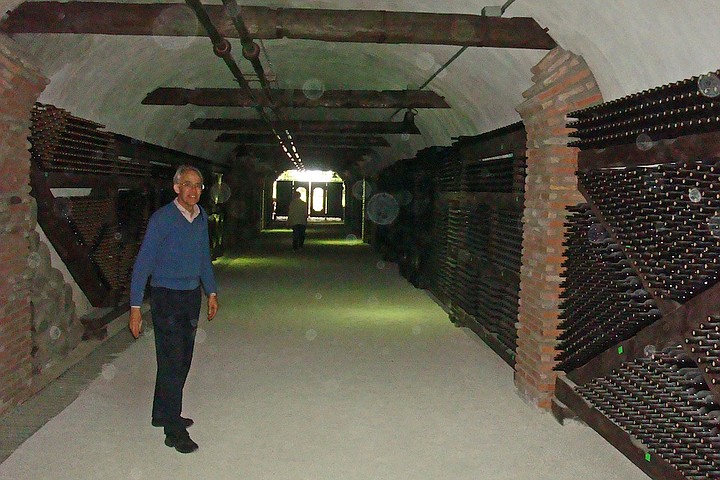
Although about four hundred varieties of grapes are grown, only about thirty-eight are produced with any frequency. But that still leaves a lot of tasting to do! We did our tasting at the Gurabi Wine Tunnel complex, where we were ushered into a four-mile-long Soviet tunnel into the mountains that used to house heavy duty missiles and tanks to protect the southern flank of the USSR. Abandoned in the 1990s, it was recently repurposed when it was discovered that it was the perfect temperature (about 55 degrees) for storing wine.
Later that night, we partook of one of the highlights of the trip: a many-course banquet called a supra. In between each course, our wine glasses were re-filled and the tamada offered toasts, starting with general tributes and becoming more and more specific as the evening wore on, with an elegance that evoked the finest of poetry. The final toast was to “everything else we forgot to mention.”
Food, wine, and monasteries are definite reasons to make a visit, but we were surprised to find yet another reason: distinctive new public buildings. This was particularly unexpected, since the country seems quite poor and so many of the old buildings were sorely in need of restoration. But although the people have very little money, the government actually has quite a lot. That’s because Georgia has the only pipeline route out of the huge Caspian Sea’s oil patch not going through Russia or Iran. The government “extracts” large royalties for the right to have oil pass through its boundaries.
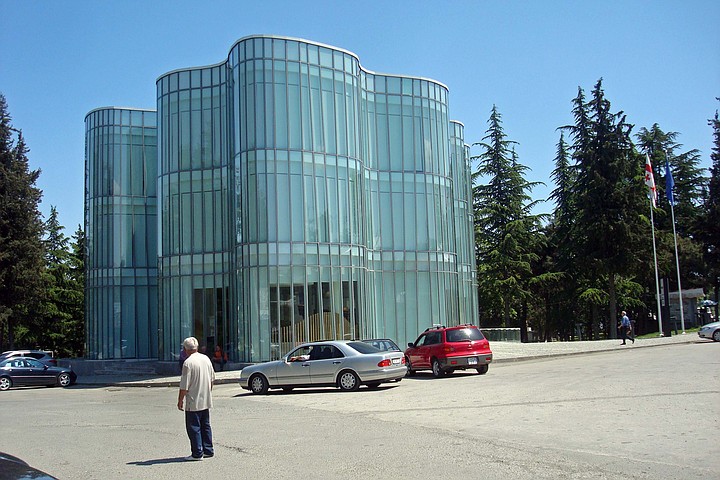
One of the things they've used the funds for is reforming the police force away from the corrupt practices it had fallen into. Almost all existing police were fired, pay was raised, and new police stations were built in exotic, futuristic designs. The huge glass expanses symbolize how nothing should happen in back rooms and that the police are there to help the public, not harass it.
Get yourself to Georgia and you'll find that the people are proud, enterprising, good-humored and high-spirited. What’s more, guests are considered blessings, and the hospitality Georgians share among themselves and with their visitors is an important part of their lives. Be part of discovering it!


Google “Georgia,” and you are much more likely to get recipes for peach pie than to learn about the unique ex-Soviet republic where wine was invented and a special language and culture survived a thousand years of foreign occupation. Today, it celebrates its links with Europe and America more than its association with the Orient.

In its capital city, Tbilisi, we saw something truly unique in the world: a major avenue named after George W. Bush!
This country of Georgia is a small swatch of land about the size of West Virginia (but with higher mountains!) at the far eastern end of the Black Sea, the bottom of Russia and the top of Iran. Other neighbors include Turkey, Armenia, Azerbaijan and Chechnya. All in all, a dicey neighborhood (which is why they cozied up to George W.)!
So, why go to Georgia? The country is definitely under-touristed. In our two weeks there, we were never even able to locate a map of Tbilisi. But just because the rest of the world hasn’t found it, doesn’t mean that there aren’t some very good reasons to visit.

Foremost on our list was the fabulous cuisine. Tasty, rich and piquant, Georgian cuisine is the natural result of a fertile, mineral-rich landscape and a parade of interloping cultures trading or invading between the East and the West. Staunchly proud of their culture, the Georgians have developed unique foods that are simply not available elsewhere. Think khachapuri, with oozy cheese enveloped in a yeast bread, fourteen varieties to choose from, and each fifty cents or less (things were generally very cheap). Or yummy eggplant with walnut sauce. Or bean stew with a delicious corn muffin sitting on top. Instead of teaspoons of spices, Georgians are apt to add a fistful of coriander or basil, and often use a blend of spices called khmeli suneli that is a complex, fragrant mixture of sour, grassy and nutty flavors.
And the best place to sample the agricultural products is at their source. To do so, we traveled to the wine country of Kakheti in a most spiffy twenty-year-old Mercedes, powered by clean and economical compressed natural gas, which seems to be the fuel of choice here.

Under the gaze of the snowcapped Caucasus Mountains, we stopped at a number of monasteries, a second reason to visit Georgia. One was Ikalto (top), established by Syrian missionaries in the 500’s A.D., and the site for the next 1,000 years of the only real higher learning academy in the region. It was burned by Persians in 1616, but still contains the remains of three churches. But even more prominent than the churches are the brothers' wine vaults, which provided the perfect venue to learn how the Georgians produce this nectar. Many archaeologists believe Georgia to be the first to cultivate grapevines over 8,000 years ago, and it is still a major source of domestic and export revenue.

Grapes are grown on every square inch of soil, and, it seemed, in the yard of every home – city and countryside alike. The traditional oenological method: once the grapes have been stomped upon and allowed to ferment (including the peel and seeds, even for white wine), the juice is placed in kvevri, large earthenware vessels lined with beeswax. These are then topped with a wooden lid and buried in the earth – or in a specially prepared wine cellar within one’s home – for at least six months. Apparently, this provides an ideal temperature for both maturation and storage.
Now that we knew how wine was produced, it was time to sample some.

Although about four hundred varieties of grapes are grown, only about thirty-eight are produced with any frequency. But that still leaves a lot of tasting to do! We did our tasting at the Gurabi Wine Tunnel complex, where we were ushered into a four-mile-long Soviet tunnel into the mountains that used to house heavy duty missiles and tanks to protect the southern flank of the USSR. Abandoned in the 1990s, it was recently repurposed when it was discovered that it was the perfect temperature (about 55 degrees) for storing wine.
Later that night, we partook of one of the highlights of the trip: a many-course banquet called a supra. In between each course, our wine glasses were re-filled and the tamada offered toasts, starting with general tributes and becoming more and more specific as the evening wore on, with an elegance that evoked the finest of poetry. The final toast was to “everything else we forgot to mention.”
Food, wine, and monasteries are definite reasons to make a visit, but we were surprised to find yet another reason: distinctive new public buildings. This was particularly unexpected, since the country seems quite poor and so many of the old buildings were sorely in need of restoration. But although the people have very little money, the government actually has quite a lot. That’s because Georgia has the only pipeline route out of the huge Caspian Sea’s oil patch not going through Russia or Iran. The government “extracts” large royalties for the right to have oil pass through its boundaries.

One of the things they've used the funds for is reforming the police force away from the corrupt practices it had fallen into. Almost all existing police were fired, pay was raised, and new police stations were built in exotic, futuristic designs. The huge glass expanses symbolize how nothing should happen in back rooms and that the police are there to help the public, not harass it.
Get yourself to Georgia and you'll find that the people are proud, enterprising, good-humored and high-spirited. What’s more, guests are considered blessings, and the hospitality Georgians share among themselves and with their visitors is an important part of their lives. Be part of discovering it!
Comments